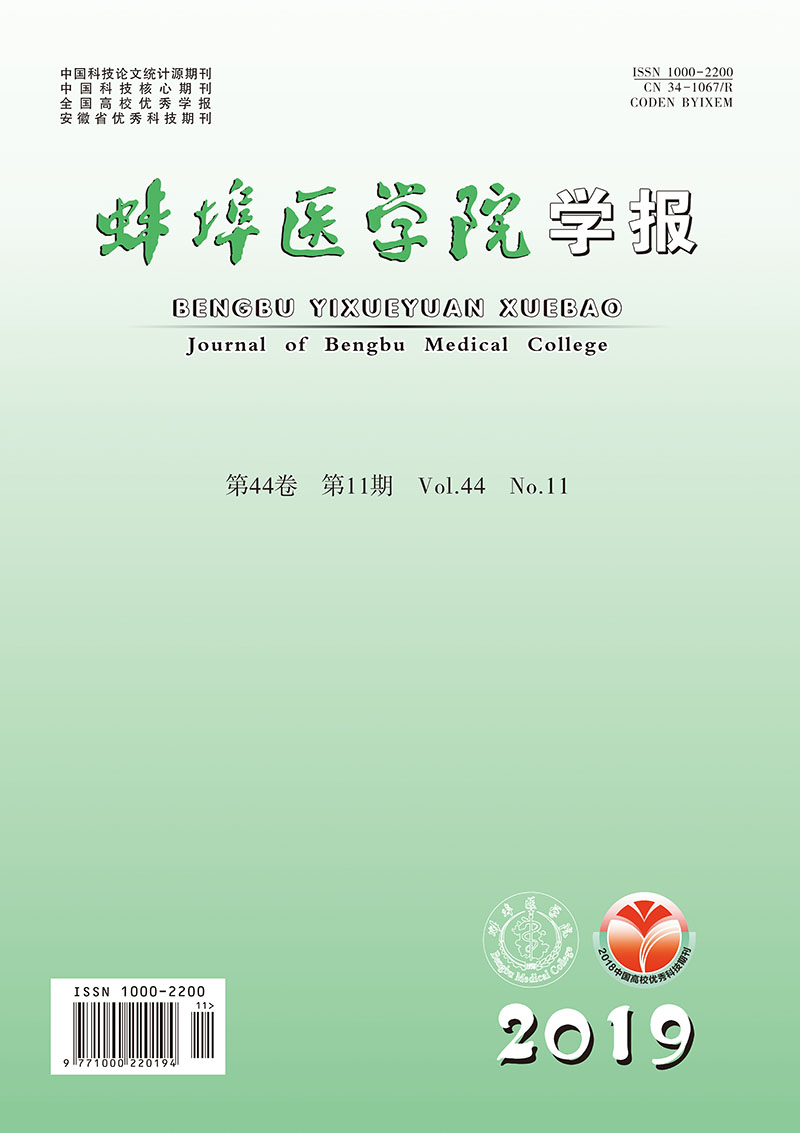-
膝关节作为人体最大且构造最复杂的关节,较容易受到损伤,而胫骨平台骨折是一种常见的膝关节损伤[1]。胫骨平台骨折作为一种典型的关节内骨折,其治疗手段影响膝关节功能的恢复[2]。而且,胫骨平台骨折常伴有半月板、膝关节韧带或膝关节软骨损伤,如果处理不当会造成膝关节功能障碍[3]。目前,治疗胫骨平台骨折的方法主要有非手术和手术治疗。手术治疗胫骨平台骨折后,由于病人受到肿胀、膝疼痛等影响,患膝不能有效恢复,严重影响病人生存质量[4]。玻璃酸钠是一种高分子多糖体生物材料,作为关节滑液的主要组分,在关节腔内起润滑作用,能够保护关节软骨,促进膝关节的恢复[5-6]。本研究选取2015年收入我院的100例胫骨平台骨折病人为研究对象,探讨锁定钢板内固定联合玻璃酸钠对胫骨平台骨折术后膝关节功能及综合应激状态的影响。现作报道。
HTML
-
选择100例胫骨平台骨折病人,根据随机数字表法分为观察组和对照组,各50例;对照组给予锁定钢板内固定,观察组给予锁定钢板内固定联合玻璃酸钠治疗。其中观察组男24例,女26例;年龄23~65岁;骨折Schatzker分型:Ⅱ型11例,Ⅲ型20例,Ⅳ型12例,Ⅴ型4例,Ⅵ型3例;外侧副韧带损伤3例,前后交叉韧带损伤5例,内侧副韧带损伤3例,闭合性骨折21例,合并半月板损伤6例,开放性骨折12例;受伤原因:压砸伤6例,坠落伤13例,交通伤31例;9例闭合骨折病人软组织肿胀消退后行内固定手术,4例开放骨折先行急诊清创术,皮肤软组织条件满意后行手术治疗。对照组男25例,女25例;年龄24~66岁;骨折Schatzker分型:Ⅱ型10例,Ⅲ型20例,Ⅳ型13例,Ⅴ型3例,Ⅵ型4例;外侧副韧带损伤4例,前后交叉韧带损伤6例,内侧副韧带损伤3例,闭合性骨折22例,合并半月板损伤7例,开放性骨折12例;受伤原因:压砸伤4例,坠落伤12例,交通伤34例;8例闭合骨折病人软组织肿胀消退后行内固定手术,3例开放骨折先行急诊清创术,皮肤软组织条件满意后行手术治疗。纳入标准:所有病人均经X线透视、MRI或CT平扫+三维重建确诊,符合胫骨平台骨折诊断[7]。排除标准:手术野皮肤有感染者;合并血管、神经损伤;凝血功能异常者;败血病;胫骨平台开放性骨折;除胫骨平台之外的其他部位骨折影响膝关节功能康复者;不参与术后康复锻炼者。2组病人的一般资料均具有可比性。本研究经医院伦理委员会批准,且所有病人自愿签署知情同意书。
-
对照组给予锁定钢板内固定手术,观察组给予锁定钢板内固定联合玻璃酸钠方式[8]。所有病人术前均行患肢石膏托外固定制动。锁定钢板内固定手术方法:病人取仰卧位,采用全身麻醉或连续硬脊膜外麻醉,根据病人骨折Schatzker分型,Ⅱ、Ⅲ型行外侧切口,Ⅳ型行内侧切口,Ⅴ、Ⅵ型行后内、前外侧联合切口。打开关节腔,胫骨平台关节面已恢复,采用克氏针(直径2 mm)固定,C型臂X线机(美国GE-7500型)透视下显示骨折已复位,行锁定钢板内固定,检查膝关节活动性良好,逐层缝合。
观察组病人关闭关节腔后,关节腔内注射玻璃酸钠注射液山东博士伦福瑞达制药有限公司,批准文号:国药准字H10960136)每次2 mL,每周一次,共5周。对照组病人不给予玻璃酸钠注射液。
术后处理:病人术后抬高患肢,并给予镇痛及常规抗生素(第三代头孢)治疗,引流管拔后,进行关节康复锻炼,每天2次,每次30 min,逐渐增加活动度。术后禁止负重行走,至复查结果显示可完全负重。
-
采用膝关节功能Rasmussen评分标准[9]:(1)主观症状,包括行走能力、有无疼痛;(2)临床体征,包括膝关节稳定性、膝关节活动度、膝关节恢复情况。分值<9分为差,10~19分为可,20~26分为良,27~30分为优。
-
检测病人术后第1周、2周及4周的膝关节功能Rasmussen评分,术后1 d、3 d及7 d的膝疼痛VAS评分,术前、术后1 d、3 d及7 d的疼痛应激[神经肽Y(NPY)、前列腺素2(PGE2)、P物质(SP)]、炎性应激[白细胞介素1β(IL-1β)、肿瘤坏死因子-α(TNF-α)、C反应蛋白(CRP)]及氧化应激指标[过氧化氢酶(CAT)、总抗氧化能力(TAC)、超氧化物歧化酶(SOD)]表达水平。术后6个月随访。
-
采用t检验、方差分析和q检验。
1.1. 一般资料
1.2. 治疗方式
1.3. 评价标准
1.4. 观察指标
1.5. 统计学方法
-
观察组病人拆线后负重时间、愈合时间均明显短于对照组(P < 0.01)(见表 1)。
分组 n 拆线后负重时间 愈合时间 观察组 50 5.24±0.28 10.56±0.72 对照组 50 5.96±0.19 11.42±1.01 t — 15.05 4.90 P — < 0.01 < 0.01 -
2组病人术后第1周、2周、4周的膝关节活动度及Rasmussen评分逐渐升高(P < 0.01),且观察组明显高于对照组(P < 0.01) (见表 2)。
分组 n 术前 术后第1周 术后第2周 术后第4周 F P MS组内 膝关节活动度 观察组 50 30.19±3.58 50.24±6.14** 71.64±7.38**## 112.32±7.54**##▲▲ 1 527.53 < 0.01 40.458 对照组 50 31.34±4.62 43.58±6.84** 61.54±6.47**## 102.84±7.68**##▲▲ 1 155.42 < 0.01 42.243 t — 1.39 5.12 7.28 6.23 — — — P — >0.05 < 0.01 < 0.01 < 0.01 — — — Rasmussen评分 观察组 50 4.09±1.38 6.69±0.85** 17.59±1.15**## 25.13±2.96**##▲▲ 1 504.45 < 0.01 39.412 对照组 50 3.95±1.29 4.72±0.78** 10.76±1.20**## 20.45±3.00**##▲▲ 913.84 < 0.01 41.102 t — 0.52 12.08 29.06 7.85 — — — P — >0.05 < 0.01 < 0.01 < 0.01 — — — q检验:与术前比较**P < 0.01;与术后第1周比较##P < 0.01;与术后第2周比较▲▲P < 0.01 -
2组病人术后1 d、3 d及7 d的膝疼痛VAS评分逐渐降低,且观察组术后3 d、7 d明显低于对照组(P < 0.01)(见表 3)。
分组 n 术前 术后1 d 术后3 d 术后7 d F P MS组内 观察组 50 7.89±1.28 7.26±0.67** 3.81±0.87**## 1.14±0.53**##▲▲ 635.14 < 0.01 0.781 对照组 50 7.93±1.35 7.34±0.69** 5.43±1.02**## 2.75±0.59**##▲▲ 295.31 < 0.01 0.846 t — 0.15 0.59 8.55 14.35 — — — P — >0.05 >0.05 < 0.01 < 0.01 — — — q检验:与术前比较**P < 0.01;与术后1 d比较##P < 0.01;与术后3 d比较▲▲P < 0.01 -
术前,2组病人NPY、PGE2、SP水平差异均无统计学意义(P>0.05);2组病人术后1 d、3 d及7 d NPY、PGE2、SP水平逐渐降低(P < 0.01),且观察组明显低于对照组(P < 0.01)(见表 4)。
分组 n 术前 术后1 d 术后3 d 术后7 d F P MS组内 NPY/(pg/mL) 观察组 50 152.64±12.85 189.64±13.64** 168.54±16.62**## 157.56±15.54**##▲▲ 62.17 < 0.01 217.222 对照组 50 152.95±13.06 228.96±19.86** 203.98±20.05**## 189.38±19.82**##▲▲ 148.46 < 0.01 214.321 t — 0.12 11.54 9.62 8.93 — — — P — >0.05 < 0.01 < 0.01 < 0.01 — — — PGE2/(pg/mL) 观察组 50 99.86±9.84 168.84±14.82** 141.82±12.62**## 119.25±10.64**##▲▲ 299.79 < 0.01 243.001 对照组 50 100.05±9.46 199.85±16.45** 174.02±15.63**## 149.34±13.21**##▲▲ 459.76 < 0.01 198.564 t — 0.10 9.90 11.33 12.54 — — — P — >0.05 < 0.01 < 0.01 < 0.01 — — — SP/(μg/mL) 观察组 50 2.89±0.27 8.01±0.95** 5.17±0.95**## 4.17±0.61**##▲▲ 421.20 < 0.01 0.654 对照组 50 2.97±0.28 10.84±1.06** 9.31±1.12**## 7.53±1.01**##▲▲ 668.26 < 0.01 0.875 t — 1.45 14.06 23.40 20.14 — — — P — >0.05 < 0.01 < 0.01 < 0.01 — — — q检验:与术前比较**P < 0.01;与术后1 d比较##P < 0.01;与术后3 d比较▲▲P < 0.01 -
术前,2组病人的IL-1β、TNF-α、CRP水平差异均无统计学意义(P>0.05);术后1 d、3 d及7 d,2组病人IL-1β、TNF-α、CRP水平均逐渐降低(P < 0.01),且观察组明显低于对照组(P < 0.01)(见表 5)。
分组 n 术前 术后1 d 术后3 d 术后7 d F P MS组内 IL-1β/(μg/L) 观察组 50 2.21±0.21 5.58±0.53** 4.61±0.50**## 2.98±0.36**##▲▲ 663.91 < 0.01 0.246 对照组 50 2.18±0.26 7.47±0.56** 6.31±0.58**## 5.34±0.47**##▲▲ 1 098.38 < 0.01 0.631 t — 0.64 17.33 15.70 28.19 — — — P — >0.05 < 0.01 < 0.01 < 0.01 — — — TNF-α/(pg/mL) 观察组 50 11.13±0.20 12.81±0.31** 12.25±0.27**## 11.63±0.24**##▲▲ 401.18 < 0.01 0.067 对照组 50 11.14±0.22 14.24±0.28** 13.84±0.32**## 13.25±0.30**##▲▲ 1 192.58 < 0.01 95.167 t — 0.24 24.21 26.85 25.02 — — — P — >0.05 < 0.01 < 0.01 < 0.01 — — — CRP/(mg/L) 观察组 50 2.71±0.57 9.21±1.01** 7.19±0.86**## 6.10±0.67**##▲▲ 583.86 < 0.01 0.958 对照组 50 2.67±0.62 12.32±1.12** 10.46±1.07**## 8.87±0.93**##▲▲ 959.90 < 0.01 0.986 t — 0.34 14.58 16.84 17.09 — — — P — >0.05 < 0.01 < 0.01 < 0.01 — — — q检验:与术前比较**P < 0.01;与术后1 d比较##P < 0.01;与术后3 d比较▲▲P < 0.01 -
术前,2组病人的CAT、TAC、SOD水平差异无统计学意义(P>0.05);术后1 d 2组CAT、SOD差异有统计学意义(P < 0.01和P < 0.05),术后3 d及7 d 2组CAT、TAC、SOD水平差异均有统计学意义(P < 0.01)(见表 6)。
分组 n 术前 术后1 d 术后3 d 术后7 d F P MS组内 CAT/(u/mL) 观察组 50 42.60±5.71 39.97±5.34* 37.56±5.20**# 40.95±5.48▲▲ 7.52 < 0.01 29.548 对照组 50 42.58±5.58 39.43±5.25* 29.86±4.57**## 34.68±4.25**##▲▲ 63.41 < 0.01 26.785 t — 0.02 0.51 7.87 6.39 — — — P — >0.05 < 0.01 < 0.01 < 0.01 — — — TAC/(u/mL) 观察组 50 11.62±1.57 10.14±1.46 8.51±1.25 10.31±1.47**▲▲ 39.07 < 0.01 1.354 对照组 50 11.61±1.59 10.05±1.42 6.29±1.13 7.51±1.23**▲▲ 158.22 < 0.01 1.874 t — 0.03 0.31 9.32 10.33 — — — P — >0.05 >0.05 < 0.01 < 0.01 — — — SOD/(u/mL) 观察组 50 76.59±6.31 70.94±6.24* 68.75±5.84** 73.30±6.27*▲▲ 14.82 < 0.01 20.251 对照组 50 76.61±6.37 68.52±5.85** 62.57±5.35** 66.31±5.91**▲▲ 50.95 < 0.01 19.554 t — 0.02 2.00 5.52 5.74 — — — P — >0.05 < 0.05 < 0.01 < 0.01 — — — q检验:与术前比较*P < 0.05,**P < 0.01;与术后1 d比较#P < 0.05;##P < 0.01;与术后3 d比较▲▲P < 0.01 -
术后6个月随访,97例胫骨平台骨折病人均骨性愈合,失访3例,其中观察组1例,对照组2例。
2.1. 2组病人拆线后负重时间及愈合时间比较
2.2. 2组病人的膝关节活动度及Rasmussen评分比较
2.3. 2组病人的膝疼痛VAS评分比较
2.4. 2组病人的疼痛应激指标比较
2.5. 2组病人的炎性应激指标比较
2.6. 2组病人的氧化应激指标比较
2.7. 随访
-
胫骨平台骨折的处理和预后严重影响病人的膝关节功能,其治疗要求较高。手术治疗主要有传统钢板内固定和锁定钢板内固定[10]。本文采用锁定钢板内固定,因为传统钢板内固定需要剥离软组织,对骨膜血供造成一定破坏,进而使骨折不愈合和感染概率升高,而锁定钢板内固定能够形成一个固定支架,稳定关节的内部结构,并且骨骼与固定支架间具有空隙,能够减轻钢板对骨折的压迫,从而减轻对血供的影响,有利于骨折恢复[11]。玻璃酸钠能够缓解病人膝关节疼痛,能够保护关节软骨,促进膝关节功能恢复。
本文研究结果显示,观察组病人的拆线后负重时间及愈合时间均明显短于对照组,说明锁定钢板内固定联合玻璃酸钠治疗胫骨平台骨折的效果较好。并且2组病人术后第1周、2周、4周的膝关节活动度及Rasmussen评分逐渐升高,且观察组明显高于对照组。推测玻璃酸钠在关节腔内具有润滑作用,可以减轻破损关节面的摩擦,缓冲震荡,并且玻璃酸钠是软骨基质的成分之一,从而有利于关节的愈合。此外,结果显示,2组病人术后1 d、3 d及7 d的膝疼痛VAS评分逐渐降低,且观察组明显低于对照组,推测由于创伤及手术等原因造成关节内韧带、滑膜肿胀,炎性细胞因子水平升高,导致病人术后膝疼痛,而玻璃酸钠可以改善关节内渗透压,促进滑膜修复,抑制巨噬细胞趋化等,从而减轻病人的膝疼痛。
随着医学技术的发展,病人对手术的要求也逐渐增多,一般采用应激反应评价病人受到的不良影响。机体应激反应主要包括疼痛、炎性及氧化应激[12]。疼痛应激会影响病人的血流动力学,从而使病人心绞痛、心跳过快等[13]。炎性应激影响病人的免疫应答,造成病人脏器功能障碍,影响病人术后恢复[14]。氧化应激造成破损关节面的微血管损伤,进而影响骨骼愈合[15]。本研究结果显示,术前3组病人NPY、PGE2、SP、IL-1β、TNF-α、CRP、CAT、TAC、SOD表达水平差异无统计学意义;术后观察组病人的疼痛应激指标NPY、PGE2、SP、IL-1β、TNF-α、CRP表达水平总体低于对照组,而观察组病人的氧化应激指标CAT、TAC、SOD表达水平则高于对照组,推测因为玻璃酸钠能够抑制巨噬细胞趋化等,从而减轻病人的疼痛应激反应,使病人的疼痛感降低;另外,玻璃酸钠能够结合糖蛋白,阻止其参与炎症反应过程,从而减轻病人的炎性应激反应;同时,玻璃酸钠与糖蛋白形成聚合体,能够修复损伤软骨,从而减轻病人的氧化应激反应。说明锁定钢板内固定联合玻璃酸钠能够减轻病人的应激反应,从而使机体受到的不良影响降低,有利于膝关节功能恢复和骨骼愈合。
综上所述,锁定钢板内固定联合玻璃酸钠对于治疗胫骨平台骨折具有良好的效果,能够减轻病人膝疼痛,减轻病人的应激反应,促进膝关节功能恢复和骨骼愈合,值得临床推广。






 DownLoad:
DownLoad: